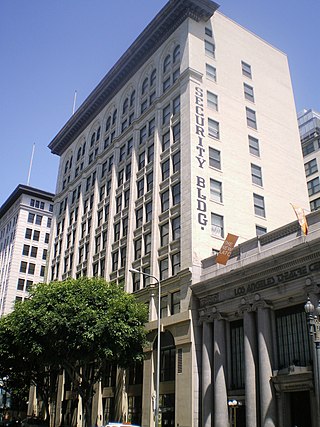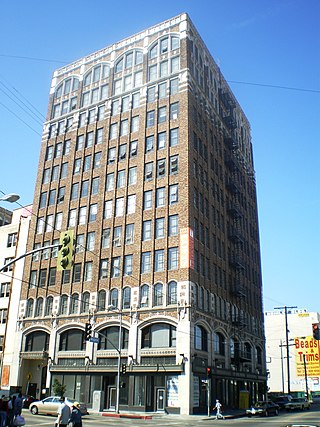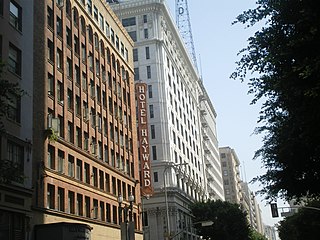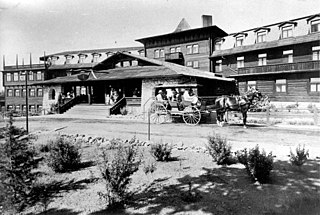
The Federal Reserve Bank of San Francisco is the federal bank for the twelfth district in the United States. The twelfth district is made up of nine western states—Alaska, Arizona, California, Hawaii, Idaho, Nevada, Oregon, Utah, and Washington—plus the Northern Mariana Islands, American Samoa, and Guam. The San Francisco Fed has branch offices in Los Angeles, Portland, Salt Lake City, and Seattle. It also has a cash processing center in Phoenix.
Claud W. Beelman, sometimes known as Claude Beelman, was an American architect who designed many examples of Beaux-Arts, Art Deco, and Streamline Moderne style buildings. Many of his buildings are listed on the National Register of Historic Places.

The A.G. Bartlett Building is a 14-floor building at 215 West Seventh Street in Downtown Los Angeles. When completed in 1911, it was the tallest building in the city for five years.

The Security Building is an 11-story high-rise building located at 510 South Spring Street within the Spring Street Financial District in Downtown Los Angeles, California. It has been converted to the residential Lofts at the Security Building.

Textile Center Building is a 12-story Gothic Revival and Italian Renaissance Revival architectural styled brick building located in the Los Angeles Fashion District. Designed by William Douglas Lee in the Gothic Revival style, the building opened in 1926 as a center for garment manufacturing. It has since been converted to condominiums.

The San Fernando Building is an Italian Renaissance Revival style building built in 1906 on Main Street in the Historic Core district of downtown Los Angeles, California. It was listed in the National Register of Historic Places in 1986, converted into lofts in 2000, and declared a Historic-Cultural Monument in 2002.

South Park Lofts, located in downtown Los Angeles, was built in 1924 as an eight-story parking garage. It was one of America's first parking structures, and is one of the few parking garages listed in the National Register of Historic Places, having received the distinction in 2004. The building has been converted to lofts and is now known as "South Park Lofts." As "Building at 816 Grand Avenue", it is one of more than ten buildings designed by Claud Beelman listed on the National Register.

Spring Street in Los Angeles is one of the oldest streets in the city. Along Spring Street in Downtown Los Angeles, from just north of Fourth Street to just south of Seventh Street is the NRHP-listed Spring Street Financial District, nicknamed Wall Street of the West, lined with Beaux Arts buildings and currently experiencing gentrification. This section forms part of the Historic Core district of Downtown, together with portions of Hill, Broadway, Main and Los Angeles streets.

The Delphi Hotel is a 12-story hotel located at 550 S Flower St in Downtown Los Angeles in the marble-clad high-rise Superior Oil Company Building formerly the headquarters of the now defunct company, converted to The Standard Downtown LA hotel in 2002, then closed in 2020 and reopened in 2023 under its current name.

The Federal Reserve Bank of Chicago Detroit Branch Building, commonly called the Federal Reserve Building, is a bank building located at 160 West Fort Street in downtown Detroit, Michigan. It was listed on the National Register of Historic Places in 2008.

The Old Federal Reserve Bank of San Francisco Building, now known as the Bently Reserve, was the main headquarters building of the Federal Reserve Bank of San Francisco for nearly sixty years. The building is located at 400 Sansome Street, in the Financial District of San Francisco. Designed by George W. Kelham, the building has an Ionic colonnade that is pure Beaux-Arts, while the upper building is in the new Moderne fashion of 1924. The banking lobby at the Sansome Street entrance contains a mural by Jules Guerin, the artist who created the palette for the 1915 Panama–Pacific International Exposition. The Old Federal Reserve was added to the National Register of Historic Places in 1984.

Walker & Eisen (1919−1941) was an architectural partnership of architects Albert R. Walker and Percy A. Eisen in Los Angeles, California.

Charles Frederick Whittlesey (1867–1941) was an American architect best known for his work in the American southwest, and for pioneering work in reinforced concrete in California.
The Federal Reserve Bank of San Francisco Los Angeles Branch is one of four branches of the Federal Reserve Bank of San Francisco. The branch is located in Los Angeles, and opened in January 1920.

The Broadway Hollywood Building is a building in Los Angeles' Hollywood district. The building is situated in the Hollywood Walk of Fame monument area on the southwest corner of the intersection referred to as Hollywood and Vine, marking the intersection of Hollywood Boulevard and Vine Street. It was originally built as the B. H. Dyas Building in 1927. The Broadway Hollywood Building is referred to by both its main address of 6300 Hollywood Boulevard and its side address of 1645 Vine Street.

The Federal Reserve Bank Building, also known as the Federal Reserve Bank of San Francisco, Seattle Branch, served as the offices of the Seattle branch of the Federal Reserve Bank of San Francisco for over 50 years, from 1951 to 2008.

















